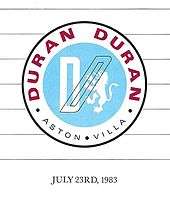Duran Duran's charity concert at Villa Park 1983

On 23 July 1983 Duran Duran staged an open air benefit concert at Villa Park, Birmingham, England[1] in front of 18,000 people who paid £8.50 a ticket to raise money for MENCAP. It was one of only two concerts that summer by the band, the other being on 20 July before the Prince and Princess of Wales at London's Dominion Theatre.
Birmingham was chosen as the venue, as it was where the band members' first met and formed the group.[2] The concert and subsequent shows in the area have always been regarded as a "homecoming".[3] This event was particularly special to Roger Taylor as he once had ambitions to be Aston Villa's goalkeeper and was a regular spectator at the ground.[4]
The show started at 6pm when the host, BBC Radio 1 presenter Peter Powell, introduced the opening act "Prince Charles and the City Beat Band", which was followed by Robert Palmer who included the songs Johnny and Mary and Some Guys Have All the Luck in his performance.[5] Friendships from this concert helped Palmer, in late 1984, to join members of Duran Duran as lead singer of the super group The Power Station.[6]
Concert
Finally, Duran Duran took to the stage at 20:40 Hrs beginning their opening song as two giant black curtains slid open revealing them on a brightly lit stage with a backdrop consisting of six inflatable Roman-style pillars designed by Henry Thompson. The band performed the following:
- Is There Something I Should Know?
- Hungry Like the Wolf
- Union of the Snake
- Lonely in Your Nightmare
- New Religion
- Night Boat
- Friends of Mine
- Save a Prayer
- Planet Earth
- My Own Way
- Hold Back The Rain
- Careless Memories
- Rio
- Fun Time
- Girls on Film
The concert finished at 22:00 Hrs with an after show "homecoming" party held at the city's Rum Runner nightclub.[7]
The programme which consists of 11 glossy double sided flyers with pictures on each side housed in a white glossy folder cost £2.00.
Duran Duran band line-up
- Simon Le Bon (vocals)
- John Taylor (bass guitar)
- Andy Taylor (guitar)
- Nick Rhodes (keyboards)
- Roger Taylor (drums)
References
- ↑ "Nostalgia: When Duran Duran rocked Aston Villa ground". Sunday Mercury. 18 July 2009.
- ↑ Laws, Roz (15 July 2008). "Duran Duran@Birmingham NEC". Sunday Mercury.
- ↑ "Duran Duran set for home town gig". BBC News.
- ↑ "Roger Taylor - New Songs, Playlists & Latest News". BBC Music.
- ↑ "Robert Palmer Biography". sing365.com.
- ↑ "80smusiclyrics.com".
- ↑ http://www.webcitation.org/query?url=http://www.geocities.com/duranies_2/1980.html&date=2009-10-25+21:32:19